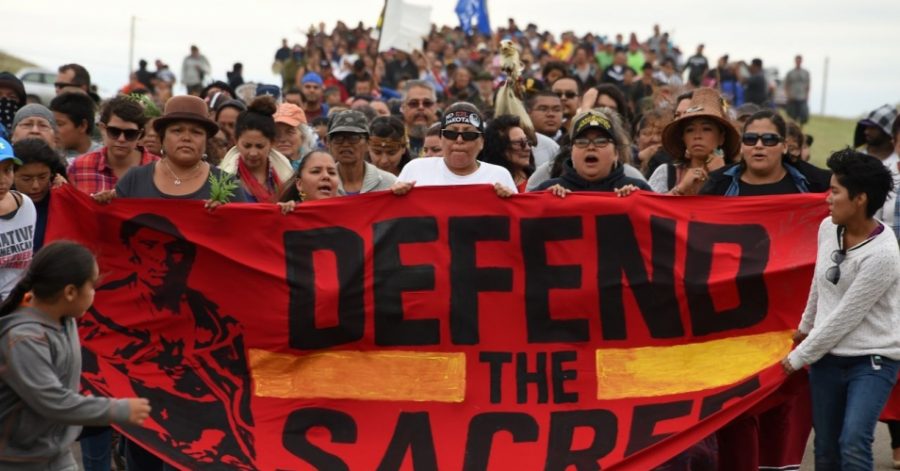As the media buzz erupts surrounding the vast controversy of the DAPL – the Dakota Access Pipeline – there’s a lot to take in and try to understand. There are social justice advocates concentrating on indigenous peoples’ rights, others arguing for the benefits of the pipeline, and some protesting on the use of the land. As police and protesters come head to head, frightening images of people injured by rubber bullets and mace employed at point blank range flood the news and social media. Amidst the fear, violence, and contention, the details of why the protesters are there in the first place is often forgotten. A clear picture of the pipeline shows that the anger in response is well merited, and once again the treatment of the indigenous people is called into question.
Proponents of the pipeline state that “the pipeline will enable domestically produced light sweet crude oil from North Dakota to reach major refining markets in a more direct, cost-effective, safer, and more environmentally responsible manner.” Financially, they state that the pipeline is a $3.7 billion dollar investment that will create many jobs. Of course these are all positive benefits, but this information completely ignores the nature of how the pipeline is constructed, and the outstanding fact that it cuts through the land of a Native American tribe.
The projected path of the pipeline cuts through the land of a Native American tribe, the Standing Rock Sioux, who were the first to protest the construction of the pipeline. The tribe noted concerns about their drinking water and damage to the land. They allege that significant damage has already been committed. “The pipeline has been rerouted 50 feet so far after the development company dug up native artifacts. The company faces heavy fines from regulators as it did not report the findings for 10 days.” Although it’s clear that the pipeline construction was never intended to degrade and invade sacred lands that belong to the tribe, it’s highly suspicious that the company had waited so long to report its damage to sacred lands. Once the DAPL controversy caught national attention, hundreds of protesters joined the Standing Rock Sioux to protest the pipeline. Tension between the police in riot gear and the passionate protesters quickly turned violent. Even the U.N. sent human rights observers to monitor the situation closely on the site.
 This event seems to have hit a nerve in the US, where native peoples’ rights have historically been ignored. The violence against the protesters by police is alarming, considering most have been peaceful, yet this incident reflects another disparagement of indigenous peoples’ health and land. One image stands out in my mind of a woman holding a prayer stick being forced onto the ground by five police officers, one of whom is jabbing her with a pole, another holding a canister of mace(pictured left). Reflective of the time when their land was taken from them by European invaders, the land controversy that surrounds DAPL shows that the fight for equal respect has yet to cease.
This event seems to have hit a nerve in the US, where native peoples’ rights have historically been ignored. The violence against the protesters by police is alarming, considering most have been peaceful, yet this incident reflects another disparagement of indigenous peoples’ health and land. One image stands out in my mind of a woman holding a prayer stick being forced onto the ground by five police officers, one of whom is jabbing her with a pole, another holding a canister of mace(pictured left). Reflective of the time when their land was taken from them by European invaders, the land controversy that surrounds DAPL shows that the fight for equal respect has yet to cease.
President Barack Obama made a statement about the pipeline, saying “my view is that there is a way for us to accommodate sacred lands of native Americans.” Furthermore, US District Judge James Boasberg has ordered a halt on construction, but “Mr. Boasberg denied a restraining order filed against the company that would further prevent alleged damage to sacred cultural sites and burial grounds of the tribe.” The question really seems to revolve around the treatment of indigenous peoples that this incident represents. In fact, the pipeline was earlier rerouted, as “the U.S. Corps of Army Engineers evaluated the [original] plan and found that the route was too close to Bismarck’s well water supply and the homes in the community.”
It seems rather hypocritical to move the pipeline to benefit some communities rather than others, and risk contaminating the water of those who seem to matter less. The double standard highlights injustices indigenous communities have faced since Europeans claimed this land as their own, with a more subtle tactic of degradation of their lands. By taking a stand against the DAPL, you may not just promote safety for the tribe, but also for the treatment of indigenous peoples as a whole. Historically, Native Americans have been subjected to less than humane treatment, but by protesting DAPL we can begin to treat the native people as they should have been treated all along—with respect and dignity. The results of DAPL will indicate if we are finally going to begin to amend the wrongs committed against the native Americans, or if our nation’s history of systematic












































































































